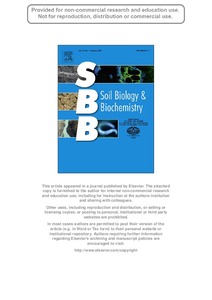| dc.contributor.author | Donner, M. |
| dc.contributor.author | Atehnkeng, J. |
| dc.contributor.author | Sikora, R.A. |
| dc.contributor.author | Bandyopadhyay, Ranajit |
| dc.contributor.author | Cotty, P.J. |
| dc.date.accessioned | 2019-12-04T11:11:44Z |
| dc.date.available | 2019-12-04T11:11:44Z |
| dc.date.issued | 2009 |
| dc.identifier.citation | Donner, M., Atehnkeng, J., Sikora, R.A., Bandyopadhyay, R. & Cotty, P.J. (2009). Distribution of Aspergillus section Flavi in soils of maize fields in three agroecological zones of Nigeria. Soil Biology and Biochemistry, 41(1), 37-44. |
| dc.identifier.issn | 0038-0717 |
| dc.identifier.uri | https://hdl.handle.net/20.500.12478/2488 |
| dc.description.abstract | Fungal communities in soils of Nigerian maize fields were examined to determine distributions ofaflatoxin-producing fungi and to identify endemic atoxigenic strains of potential value as biologicalcontrol agents for limiting aflatoxin contamination in West African crops. Over 1000 isolates belonging toAspergillussection Flavi were collected from soil of 55 Nigerian maize fields located in three agro-ecological zones by dilution plating onto modified Rose Bengal agar. The most common member ofAspergillussection Flavi (85% of isolates) was theA. flavusL-strain followed by the unnamed taxon knownas strain SBG(8%),A. tamarii(6%) andA. parasiticus(1%). Highest incidence of SBGwas in Zaria district, andlowest was in Ogbomosho and Ado-Ekiti districts. Only 44% of 492A. flavusisolates produced aflatoxinsin liquid fermentation (limit of detection 5 ng g 1). Thirty-two percent of theA. flavusisolates produced>1mgg 1total aflatoxins but noA. flavusisolate produced G aflatoxins. When the agroecological zoneswere compared, significantly (P<0.05) greater proportions of aflatoxigenicA. flavusisolates were foundin the Northern Guinea Savannah (61%) than in Southern Guinea Savannah (31%). The Derived Savannahwas intermediate between the other two agroecological zones. Each of the regions had atoxigenic strainsof potential value as biological control agents. All SBGandA. parasiticusisolates produced both B andG aflatoxins and greater than 300mgg 1total aflatoxins. SBGandA. parasiticusisolates were the greatestcontributors to the aflatoxin-producing potential of fungal communities in regions where these isolatesoccurred. |
| dc.description.sponsorship | Federal Ministry for Economic Cooperation and Development, Germany |
| dc.format.extent | 37-44 |
| dc.language.iso | en |
| dc.subject | Aflatoxins |
| dc.subject | Aspergillus Section |
| dc.subject | Flavi |
| dc.subject | Sbg |
| dc.subject | Atoxigenic |
| dc.subject | Groecological Zones |
| dc.subject | A. Parasiticus |
| dc.title | Distribution of Aspergillus section Flavi in soils of maize fields in three agroecological zones of Nigeria |
| dc.type | Journal Article |
| dc.description.version | Peer Review |
| cg.contributor.affiliation | University of Bonn |
| cg.contributor.affiliation | International Institute of Tropical Agriculture |
| cg.contributor.affiliation | University of Ibadan |
| cg.contributor.affiliation | University of Arizona |
| cg.coverage.region | Acp |
| cg.coverage.region | Africa |
| cg.coverage.region | Europe |
| cg.coverage.region | West Africa |
| cg.coverage.region | North America |
| cg.coverage.country | Germany |
| cg.coverage.country | Nigeria |
| cg.coverage.country | United States |
| cg.isijournal | ISI Journal |
| cg.authorship.types | CGIAR and developing country institute |
| cg.iitasubject | Aflatoxin |
| cg.iitasubject | Agronomy |
| cg.iitasubject | Disease Control |
| cg.iitasubject | Farm Management |
| cg.iitasubject | Farming Systems |
| cg.iitasubject | Integrated Soil Fertility Management |
| cg.iitasubject | Maize |
| cg.iitasubject | Soil Information |
| cg.iitasubject | Soil Fertility |
| cg.journal | Soil Biology and Biochemistry |
| cg.howpublished | Formally Published |
| cg.accessibilitystatus | Limited Access |
| local.dspaceid | 93239 |
| cg.identifier.doi | https://dx.doi.org/10.1016/j.soilbio.2008.09.013 |

